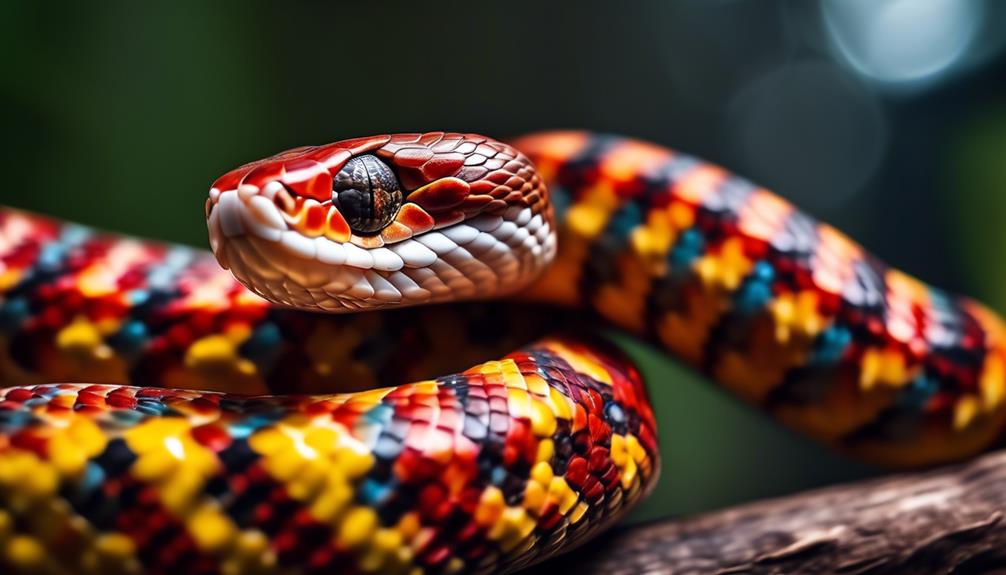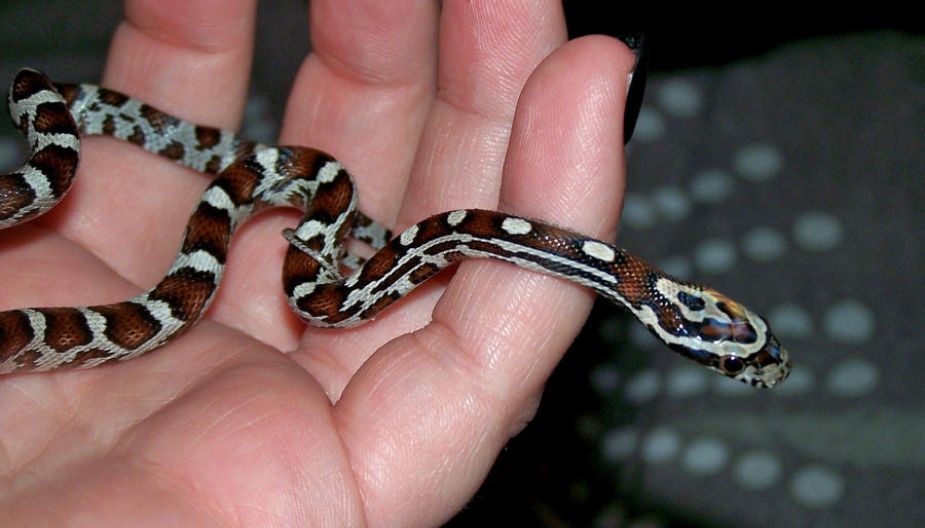You may not realize it, but the world of corn snake morphs holds a fascinating array of colors and patterns waiting to be uncovered.
As you begin to explore the intricate genetic variations that give rise to the mesmerizing diversity of these snakes, you’ll find yourself captivated by the complex interplay of traits that shape their stunning appearances.
But what exactly makes each morph unique, and how do these genetic marvels continue to intrigue and enchant enthusiasts?
Stay tuned to unravel the captivating secrets behind the colorful world of corn snake morphs and gain a deeper understanding of their mesmerizing allure.
And if you want to delve even further into the world of reptiles, be sure to visit Freptiles, a leading website for reptile enthusiasts.
Exploring Corn Snake Morphs
Now, let’s explore the fascinating world of corn snake morphs. These genetic variations result in a diverse array of color patterns and combinations, making each morph unique.
From classic color morphs like the amelanistic and anerythristic variations to the stunning rainbow morphs, the world of corn snake genetics offers a captivating look into the intricacies of heredity and pigmentation.
What is a Corn Snake Morph?
Corn snake morphs are the result of genetic mutations that manifest in a variety of unique and visually striking physical appearances. These mutations can lead to a wide array of color and pattern variations in corn snakes, giving rise to a diverse range of morphs.
Rainbow corn snake morphs, characterized by vibrant and iridescent hues, are particularly sought after for their stunning visual appeal. Albino corn snake morphs, on the other hand, lack the typical dark pigmentation, resulting in a strikingly light appearance with red or pink eyes.
In addition to these popular morphs, there are also rare corn snake morphs that exhibit exceptional and unusual colorations, making them highly prized among enthusiasts. Understanding the genetic basis of these morphs provides valuable insights into the fascinating world of corn snake diversity.
Corn Snake Color Morphs
Exploring the fascinating world of corn snake morphs reveals a rich tapestry of color variations that captivate enthusiasts and contribute to the species’ diversity. Corn snakes display a wide array of color morphs, making them popular among reptile enthusiasts. The table below showcases some of the different corn snake morphs, including the snow morph corn snake and amel corn snake morphs.
| Morph Type | Description |
|---|---|
| Normal | Traditional corn snake coloration |
| Snow | White and pink coloration |
| Amel | Bright red and orange coloration |
| Anery | Lack of red pigmentation |
The variety of corn snake color morphs allows for a captivating range of appearances, contributing to the allure of these reptiles as pets and the ongoing fascination with their genetics and breeding.
Rainbow Corn Snake Morphs
Rainbow corn snake morphs expand the already captivating array of color variations found in corn snakes, adding a vibrant and diverse spectrum to the species’ genetic palette. These morphs exhibit a breathtaking range of colors, from vivid reds and oranges to striking yellows and greens, creating a mesmerizing kaleidoscope of hues.
When exploring rainbow morph variations, you’ll encounter an assortment of captivating patterns and color combinations, making them some of the coolest corn snake morphs available. Utilizing a corn snake morph calculator can aid in understanding the genetic makeup behind these stunning variations.
Tools for Understanding Corn Snake Morphs
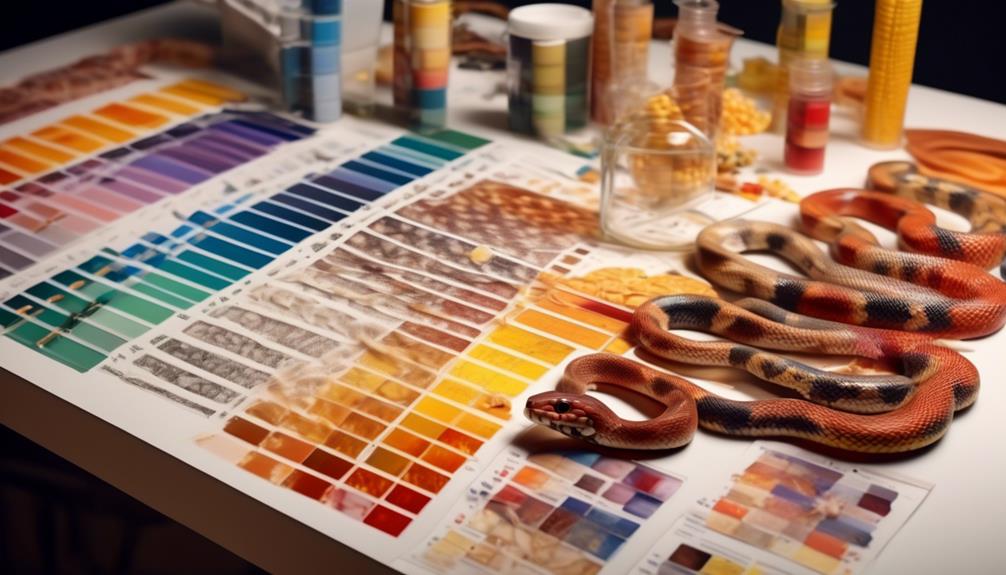
To better understand corn snake morphs, you can utilize tools such as the Corn Snake Morph Calculator and the Corn Snake Morphs Chart.
These resources provide valuable information on the genetic makeup and visual characteristics of different corn snake morphs.
Corn Snake Morph Calculator
The utilization of a specialized Corn Snake Morph Calculator facilitates the precise prediction of genetic outcomes for breeding purposes. This tool is invaluable for breeders seeking to understand the potential color and pattern combinations that may result from specific pairings of corn snakes. By inputting the genetic information of the parent snakes, the calculator can predict the potential offspring morphs, aiding breeders in making informed decisions to achieve desired results. Below is an example of a Corn Snake Morph Calculator table:
| Gene | Possible Offspring Morphs |
|---|---|
| Amel | 50% Amel, 50% Normal |
| Anery | 50% Anery, 50% Normal |
| Diffused | 50% Diffused, 50% Normal |
| Hypo | 50% Hypo, 50% Normal |
| Scaleless | 50% Scaleless, 50% Normal |
This tool simplifies the complex genetic combinations, allowing breeders to strategize and plan their breeding programs effectively.
Corn Snake Morphs Chart
Understanding the intricate variations in corn snake morphs is essential for enthusiasts and breeders alike, as it provides valuable insights into the genetic diversity and potential outcomes of breeding programs.
A comprehensive corn snake morphs chart serves as a vital tool for understanding the diverse array of morphs available in the market. This chart categorizes different morphs based on their visual representation, allowing for easy identification and comparison. It provides a detailed corn snake morph guide, offering information on the common corn snake morphs, such as albino and the striking blood red morph corn snake.
The chart may include images or color swatches of each morph, along with their genetic makeup and specific characteristics.
Diving into Diversity
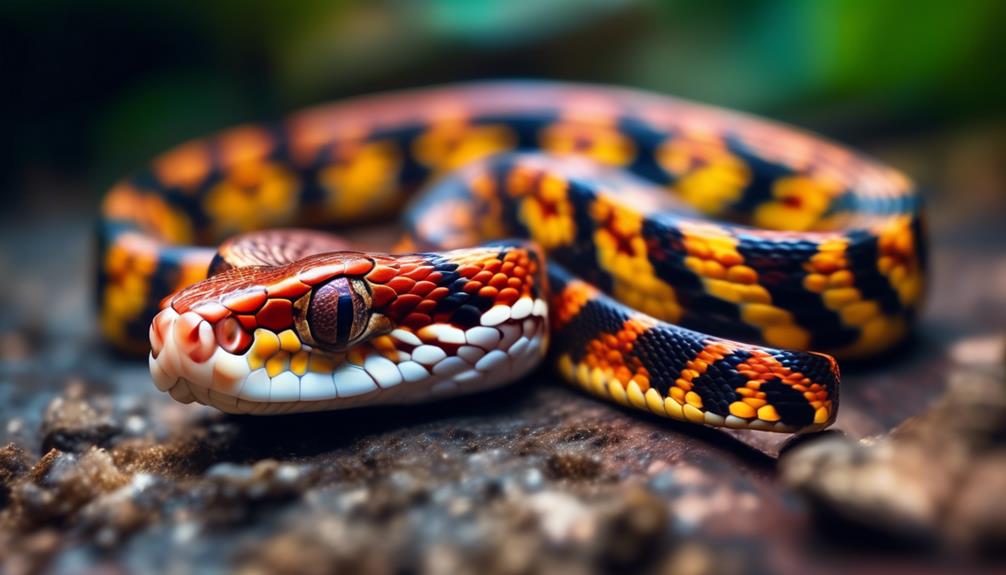
Now, let’s examine the diverse range of corn snake morphs.
Various morphs exhibit distinct patterns and colors, adding to the allure of these reptiles.
From the popular albino morph to the rare snow morph, there’s a wide spectrum of genetic variations that contribute to the fascinating diversity of corn snakes.
Different Corn Snake Morphs
Exploring the vast array of corn snake morphs reveals a mesmerizing spectrum of colors and patterns that captivate reptile enthusiasts and breeders alike. The best corn snake morphs showcase a stunning variety, including the black and white corn snake morph, which features striking contrast and bold patterns.
The blizzard morph corn snake, characterized by its clean, white appearance with subtle flecks of color, offers a unique and ethereal beauty. Additionally, the blue corn snake morph displays a captivating iridescence, with hues reminiscent of a clear summer sky.
Another remarkable morph is the candy cane corn snake, boasting vibrant red and white bands that resemble the classic confectionery. Each of these morphs demonstrates the fascinating genetic diversity within the corn snake species, making them highly sought after in the reptile breeding community.
Assorted Corn Snake Morphs
With an array of unique genetic variations, assorted corn snake morphs present a captivating display of diversity in color and pattern.
The corn snake ghost morph, characterized by a pale, almost translucent appearance due to reduced melanin production, is a striking example of this diversity.
Another fascinating morph is the corn snake lavender morph, which features a light purple or lavender hue and is highly sought after by enthusiasts.
When identifying these assorted morphs, it’s crucial to pay attention to specific markers such as eye color, belly scales, and head patterns.
However, it’s important to note that while exploring the world of corn snake morphs, there are certain morphs to avoid due to ethical concerns, such as those associated with health issues or unsustainable breeding practices.
Understanding and appreciating the diverse array of corn snake morphs adds depth to the fascinating world of herpetoculture.
Rare Corn Snake Morphs
Diving into the realm of rare corn snake morphs unveils an intricate tapestry of genetic variations that captivate enthusiasts and present unique breeding challenges. These rare corn snake morphs, while captivating, are challenging to identify due to their subtle differences. Some rare morphs may exhibit atypical coloration or pattern variations that require a keen eye and understanding of genetic inheritance.
Breeding rare corn snake morphs can be complex, as it often involves working with recessive genes and carefully selecting breeding pairs to produce desired traits. Additionally, rare morphs may have limited availability in the market, making them highly sought after by collectors and enthusiasts.
These unique genetic variations contribute to the diversity and allure of the corn snake, a beloved reptile among enthusiasts.
Snow Morph Corn Snake
Snow morph corn snakes, characterized by their stunning and unique coloration, offer a fascinating exploration into the diverse genetic spectrum of these captivating reptiles. These snakes exhibit a striking appearance, featuring a light background color with beautiful specks of pink, lavender, and gray. The table below provides a guide to understanding the genetics and appearances of snow morph corn snakes.
| Aspect | Description |
|---|---|
| Coloration | Light background with pink, lavender, and gray |
| Pattern | Reduced or absent red pigment |
| Eyes | Typically blue or gray |
| Breeding Considerations | Snow morphs are homozygous for amelanism and require specific breeding for consistent offspring |
Snow morph corn snakes are not only visually appealing but also make for adorable pets, especially as babies with their unique coloring. Understanding the genetics and characteristics of snow morphs can guide breeders and enthusiasts in appreciating the diversity within the corn snake morphs.
Albino Corn Snake Morphs
The albino corn snake morph, known for its striking lack of melanin and vivid coloration, has garnered significant attention in the pet trade due to its captivating appearance and genetic diversity.
Albino corn snake morphs are non-venomous and make excellent pets due to their docile nature and manageable size. The cute and charming appearance of albino corn snake morphs has contributed to their popularity among reptile enthusiasts.
Genetic charts are used to track and understand the variations within albino corn snake morphs, allowing breeders to predict and create specific color variations. These morphs exhibit a wide range of colors and patterns, showcasing the intricate genetic diversity present within the albino corn snake morph population.
Amel Corn Snake Morphs
With the wide array of color variations and genetic diversity observed in albino corn snake morphs, our focus now shifts to the intricate world of amel corn snake morphs, shedding light on their unique characteristics and genetic complexity. The amelanistic, or amel, corn snake morph is characterized by a lack of melanin, resulting in a beautiful display of red, orange, yellow, and brown hues. This morph is highly sought after by enthusiasts for its vibrant and striking appearance. The amel corn snake is a popular choice among breeders due to its genetic simplicity, making it an ideal candidate for understanding inheritance patterns and genetic calculations using Punnett squares or online genetic calculators. When housing an amel corn snake, it is crucial to provide a suitable enclosure with proper heating and humidity levels to ensure its health and well-being.
| Amel Corn Snake Morphs | |
|---|---|
| Characteristics | Lack of melanin |
| Popular among enthusiasts | Vibrant appearance |
| Genetic simplicity | Breeding purposes |
| Genetic calculations | Punnett squares |
| Enclosure requirements | Heating and humidity levels |
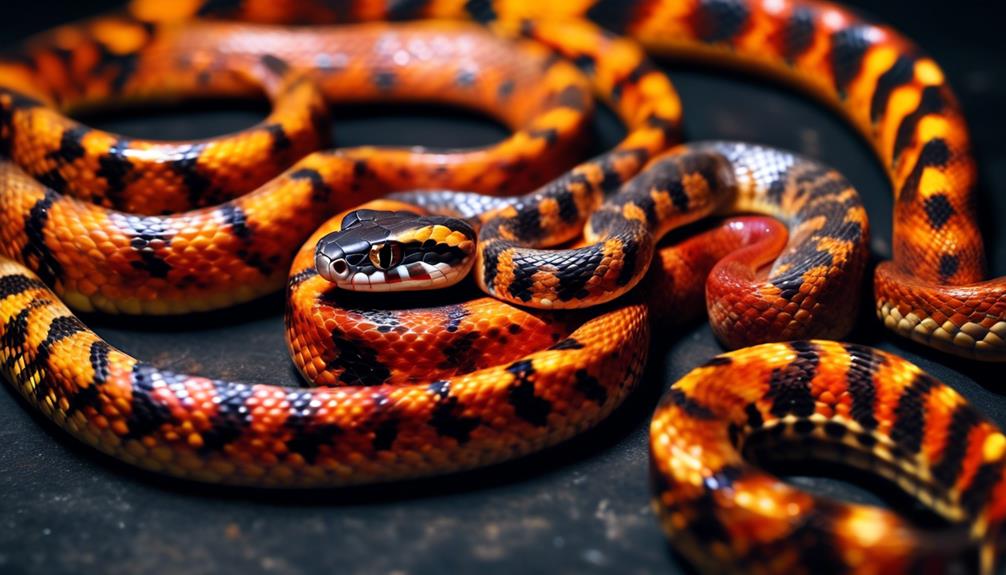
When navigating the spectrum of corn snake morphs, it’s essential to consider the wide array of colors and patterns that exist within this species.
The best corn snake morphs exhibit striking combinations of pigmentation, resulting in visually captivating specimens.
From the stark contrast of the black and white corn snake morph to the mesmerizing hues of the blizzard, blood red, and blue morphs, each variation offers a unique insight into the genetic diversity of these reptiles.
Best Corn Snake Morphs
Navigating the spectrum of corn snake morphs reveals an array of vibrant and captivating color variations that have captivated enthusiasts and pet owners alike. When it comes to the best corn snake morphs, several stand out for their unique combinations of color and pattern, driven by genetics and selective breeding.
Some of the most popular corn snake morphs include:
- Okeetee: Known for its classic red-orange background color with bold black-bordered dorsal blotches.
- Anerythristic: This morph lacks red pigmentation, resulting in a striking grayscale appearance with black and white hues.
- Lavender: Exhibiting a soft purple and pinkish hue, this morph is highly sought after for its pastel-like colors.
These morphs showcase the diverse and mesmerizing palette that corn snakes offer, making them highly desirable among reptile enthusiasts.
Black and White Corn Snake Morph
The captivating array of corn snake morphs encompasses a spectrum of colors and patterns, with each variation presenting its unique aesthetic appeal and genetic considerations.
The black corn snake morph is a striking variation characterized by its jet-black coloration contrasted with bold white markings. This morph’s aesthetic allure has made it highly sought after among enthusiasts.
Breeding considerations for this morph are crucial, as it’s essential to avoid certain corn snake morphs to maintain the purity of the black and white morph.
When caring for black and white corn snakes, it’s important to provide a small, well-equipped terrarium or tank to accommodate their size and ensure their comfort.
Understanding the intricacies of this morph’s genetics and providing suitable housing are essential for successfully keeping and breeding these captivating snakes.
Blizzard Morph Corn Snake
Have you ever wondered about the genetic intricacies that define the captivating blizzard morph in corn snakes? The blizzard morph is a stunning variation characterized by a lack of pattern and a predominantly white or light gray body color. This morph is the result of a genetic mutation that affects the pigmentation and pattern development in corn snakes, resulting in a mesmerizing appearance that has captivated reptile enthusiasts.
- Genetic Mutation: The blizzard morph is the result of a specific genetic mutation that alters the pigmentation and pattern development in corn snakes.
- Lack of Pattern: One of the defining features of the blizzard morph is the absence of the typical pattern seen in other corn snake morphs, resulting in a sleek and minimalist appearance.
- Breeding Challenges: Breeding blizzard morphs can present challenges due to the genetic intricacies involved, requiring careful selection and breeding practices to maintain the purity of the morph.
The blizzard morph exemplifies the mini marvels of genetic diversity within the captivating world of corn snake morphs.
Blood Red Morph Corn Snake
Exploring the genetic intricacies of the blood red morph in corn snakes reveals a captivating spectrum of color and pattern variations.
This morph is characterized by a stunning red coloration that can range from a deep, rich crimson to a vibrant, fiery red.
The striking coloration is complemented by a clean, unbroken pattern, creating a visually impactful appearance.
From a genetic standpoint, the blood red morph is the result of selective breeding to enhance the expression of red pigmentation while minimizing other colorations.
Breeders carefully consider the genetic traits of the parent snakes to achieve the desired outcome, often focusing on the influence of specific genes related to pigmentation.
Understanding the intricacies of the blood red morph not only showcases the beauty of nature but also highlights the complex interplay of genetics in producing diverse corn snake morphs.
Blue Corn Snake Morph
Navigating the spectrum of corn snake morphs reveals the captivating intricacies of the blue morph, showcasing a stunning range of color variations and patterns.
The blue corn snake morph presents a mesmerizing array of hues, from pale icy blue to deep, rich indigo. This morph often features intricate patterns, such as speckling, striping, and blending of different shades. The intensity and vibrancy of the blue coloration can vary depending on individual genetics and environmental factors.
Blue corn snakes are highly sought after by enthusiasts due to their striking appearance and unique coloration. Maintaining the vividness of their blue hues requires careful consideration of factors like lighting, temperature, and diet to ensure the continued vibrancy of this mesmerizing morph.
Candy Cane Corn Snake Morph
The candy cane corn snake morph displays a distinctive pattern of alternating red and white bands along its body, creating a visually striking and unique appearance. These bands are crisp and well-defined, with the red coloration ranging from deep crimson to vibrant cherry red, while the white bands can vary from pure white to a soft pinkish hue.
The genetic makeup of the candy cane morph involves specific combinations of alleles that dictate the formation of these striking color patterns. Breeders face challenges in consistently producing this morph due to the need for precise genetic pairings, but the rewards are high due to the allure of the candy cane’s eye-catching appearance.
This morph continues to captivate enthusiasts and breeders alike, adding to the diverse spectrum of corn snake morphs.
The Fascination Continues

As you continue your exploration of corn snake morphs, the fascination only grows as you discover the wide array of colors and patterns that these snakes can exhibit. From the common morphs that showcase classic corn snake colors to the cool and coolest morphs that push the boundaries of visual diversity, each variation offers a unique and captivating spectacle.
Keep an eye out for the mesmerizing Corn Snake Ghost Morph and the enchanting Corn Snake Lavender Morph, as they add an extra layer of intrigue to the already captivating world of corn snake morphs.
Common Corn Snake Morphs
Common corn snake morphs exhibit a diverse array of captivating colors and patterns, reflecting the intricate genetic variations present in this popular pet species. These morphs are highly sought after for their unique appearances and include:
- Albino: Displaying a lack of melanin, these snakes feature stunning red eyes and vibrant orange, yellow, and white hues.
- Anerythristic: Lacking red and yellow pigments, these snakes showcase grayscale and silver tones, creating a striking contrast.
- Hypomelanistic: Characterized by reduced black pigment, these snakes exhibit lighter backgrounds with distinct, crisp patterns.
These common morphs are prevalent in the pet trade due to their visual appeal, making them highly desirable among enthusiasts and collectors.
Understanding the genetic basis of these morphs provides valuable insights into the intricate world of corn snake breeding and genetics.
Cool Corn Snake Morphs
Exploring further into the captivating realm of corn snake morphs reveals a myriad of cool and unique features that continue to captivate enthusiasts and collectors alike. These morphs showcase a stunning array of colors and patterns, making them highly sought after in the reptile community. Below is a table highlighting some of the most fascinating cool corn snake morphs:
| Morph Name | Description | Unique Feature |
|---|---|---|
| Lavender | Soft purple hues with pink undertones | Uncommon in the wild, strikingly beautiful |
| Strawberry | Pinkish-red body with speckled pattern | Rare and highly prized for its vibrant appearance |
| Blizzard | Pure white with no pattern or markings | Stunning lack of pigmentation, unique albino trait |
| Scaleless | Smooth scales or complete scale absence | Uncommon and visually intriguing |
| Pewter | Grayish body with darker markings | Uniquely muted coloration, highly distinctive |
These cool corn snake morphs continue to capture the imagination of reptile enthusiasts, adding to the allure of these captivating creatures.
Coolest Corn Snake Morphs
- Rare genetic mutations
- Unparalleled visual appeal
- Contrast between light and dark hues
- Intricate banding
- Iridescent sheen
- Presence of unexpected color variations
- Interaction with light
- Sought after in reptile breeding and pet ownership
Corn Snake Ghost Morph
Unveiling the ethereal and enigmatic characteristics of the Corn Snake Ghost Morph reveals a mesmerizing genetic trait that sets it apart from other morphs.
This morph exhibits a unique appearance, with a pale, almost translucent skin that gives it an otherworldly, ghostly quality. The ghost morph is the result of a recessive genetic mutation that affects the production of melanin, the pigment responsible for skin coloration in corn snakes.
As a result, the ghost morph displays a stunning combination of light grey, silver, and pink hues, creating a truly captivating sight for snake enthusiasts. This genetic trait has captivated breeders and enthusiasts alike, leading to a continued fascination with the ghost morph and its mysterious, almost supernatural, appearance.
Corn Snake Lavender Morph
The Corn Snake Lavender Morph, characterized by its distinct pale purple coloration, has garnered significant attention among snake enthusiasts and breeders.
This visually striking morph exhibits a range of lavender hues, from soft pastel shades to deeper, more intense tones. The lavender coloration is a result of specific genetic traits, and breeders carefully select and pair snakes to enhance and maintain this sought-after color.
When breeding lavender morphs, it’s crucial to consider genetic diversity to avoid potential health issues associated with inbreeding. Additionally, maintaining the vibrancy of the lavender coloration requires attention to environmental factors such as temperature and humidity levels.
As a result, the breeding and care of Corn Snake Lavender Morphs demand meticulous planning and expertise.
A Guide to Corn Snake Morphs

When it comes to identifying corn snake morphs, it’s crucial to understand the specific characteristics and traits that define each morph.
This guide will provide you with the knowledge needed to identify various corn snake morphs, allowing you to make informed decisions when selecting a pet.
Additionally, you’ll learn about certain morphs that should be approached with caution due to potential health and ethical considerations.
Corn Snake Morph Guide
Understanding corn snake morphs is essential for both novice and experienced snake enthusiasts, as it unveils the diverse array of color patterns and genetic variations present in these captivating reptiles. When delving into the world of corn snake morphs, it’s crucial to consider the following:
- Genetic Basis: Each morph is the result of specific genetic mutations, leading to distinct color and pattern variations.
- Identification Techniques: Learning to identify different morphs involves understanding subtle differences in color, pattern, and scale characteristics.
- Breeding Considerations: For breeding purposes, it’s important to have a deep understanding of the genetics behind different morphs to predict the outcomes of pairings accurately.
Corn Snake Morph Identification
To identify corn snake morphs, carefully examine the distinct color patterns and scale characteristics, as these features are indicative of specific genetic mutations. Corn snake morphs are identified based on their unique visual traits, which are a result of selective breeding for specific genetic mutations. Below is a table outlining some common corn snake morphs:
| Morph | Description | Characteristics |
|---|---|---|
| Amelanistic | Lacking black pigment | Reddish-brown with white sides |
| Anerythristic | Lacking red pigment | Gray with black borders |
| Hypomelanistic | Reduced black pigment | Light brown with dark markings |
| Lavender | Pinkish-purple hue | Gray with pinkish hues |
Understanding these characteristics is essential for correctly identifying and appreciating the diverse array of corn snake morphs available in the pet trade.
Corn Snake Morphs to Avoid
Avoid purchasing corn snake morphs with complex genetic traits that can lead to health issues, as these may pose challenges for keepers and require specialized care. When selecting a corn snake morph, it’s important to consider the potential health implications and the care requirements associated with certain genetic traits.
Here are some corn snake morphs to avoid:
- Spider Morph: This morph is associated with a neurological condition known as ‘wobble syndrome’, which can affect the snake’s coordination and overall well-being.
- Scaleless Morph: Corn snakes with the scaleless trait are prone to skin-related issues and injuries, requiring meticulous husbandry practices to prevent complications.
- Super Caramel Corn Snake: This morph carries the homozygous form of the caramel albino gene, which has been linked to visual impairments and other health concerns.
It is crucial to prioritize the welfare of the snakes when considering different morphs for your collection.
Frequently Asked Questions
How Do Corn Snake Morphs Contribute to the Overall Health and Well-Being of the Snake?
Corn snake morphs contribute to overall health and well-being by promoting genetic diversity and reducing the risk of inbreeding. This diversity can enhance resilience to diseases and environmental changes, ensuring a healthier snake population.
Are There Any Ethical Considerations to Keep in Mind When Breeding or Purchasing Corn Snake Morphs?
When breeding or purchasing corn snake morphs, consider ethical implications. Ensure responsible breeding practices, prioritize snake health and well-being, and support reputable breeders who prioritize genetic diversity and avoid harmful traits. Choose consciously.
Can Corn Snake Morphs Interbreed With Other Snake Species, and if So, What Are the Potential Outcomes?
Yes, corn snake morphs can interbreed with other snake species. Potential outcomes include hybridization, producing offspring with mixed characteristics. This can impact genetic purity and conservation efforts for both corn snakes and the other species involved.
What Are Some Common Misconceptions About Corn Snake Morphs and Their Care Requirements?
You’ve probably heard that corn snake morphs need special care, but it’s a common misconception. In reality, their care requirements are similar to wild-type corn snakes. Proper husbandry, diet, and habitat are crucial for all morphs.
How Do Environmental Factors Impact the Appearance and Behavior of Corn Snake Morphs?
Environmental factors can significantly impact the appearance and behavior of corn snake morphs. Factors like temperature, humidity, and diet play a crucial role in shaping their coloration, size, and overall health. Proper environmental conditions are essential for their well-being.
Conclusion
As you journey through the intricate world of corn snake morphs, you’re like a scientist exploring the depths of a colorful genetic code. Each morph is a unique puzzle piece, adding to the captivating tapestry of these reptiles.
Just as a scientist unravels the mysteries of the natural world, you have delved into the genetics and diversity of corn snake morphs, unlocking the secrets behind their mesmerizing appearances.
The allure of these captivating serpents continues to fascinate and inspire. And if you want to explore more about these fascinating creatures, you can visit Freptiles, a website brand that specializes in reptile genetics and morphs.
